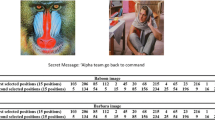Abstract
Commonly used security mechanisms such as cryptography and steganography suffer from weaknesses when used in a standalone manner. Extra efforts in the form of additional permutations/diffusions etc. result in higher ciphering/deciphering time complexity. Thus, there is a requirement for a security mechanism(s) which can provide adequate security without putting a considerable burden on ciphering/deciphering time complexity. This paper is an effort in this direction. The paper proposes a hybrid mechanism that employs chaotic based encryption scheme to encrypt data and an improved Bit-Plane Complexity Segmentation Steganography algorithm to embed the data. The proposed mechanism uses two new complexity measures to differentiate between noisy regions and simple ones appropriately. The scheme was implemented in MATLAB, and the simulation results show that the proposed mechanism has high embedding capacity, high security with a moderate decrease in PSNR value and is computationally fast.






















Similar content being viewed by others
References
Alia MA, Yahya A (2010) Public–key steganography based on matching method. Eur J Sci Res 40(2):223–231
Bansal R, Gupta S, Sharma G (2016) An innovative image encryption scheme based on chaotic map and Vigenère scheme. Multimedia Tools and Applications 1–34. doi:10.1007/s11042-016-3926-9
Bansal R, Chawla R, Gupta S (2016) A comparison of image encryption techniques based on chaotic maps. In computing for sustainable global development (INDIACom), 2016 3rd international conference on. IEEE, pp 933–938
Chaudhary D, Gupta S, Kumari M (2016) A novel hybrid security mechanism for data communication networks. International Journal of Information Privacy, Security and Integrity 2(3):216–231
François M, Grosges T, Barchiesi D, Erra R (2012) A new image encryption scheme based on a chaotic function. Signal Process Image Commun 27(3):249–259
Goel S, Rana A, Kaur M (2013) A review of comparison techniques of image steganography. Global J Comp Sci Technol 13(4):9–14
Gokul M, Umeshbabu R, Vasudevan SK, Karthik D (2012) Hybrid steganography using visual cryptography and LSB encryption method. Int J Comput Appl 59:5–8
Gupta S, Goyal A, Bhushan B (2012) Information hiding using least significant bit steganography and cryptography. In I.J. Modern Education and Computer Science 6: 27–34
Habes A (2006) Information hiding in BMP image implementation, analysis and evaluation. Saint Petersburg Institute for Informatics 6:1–10
Hanchinamani G, Kulkarni L (2015) An Efficient Image Encryption Scheme Based on a Peter De Jong Chaotic Map and a RC4 Stream Cipher. 3D Res 6(3):30
Huffman DA (1952) A method for the construction of minimum-redundancy codes. Presented at the Proceedings of the IRE 40(9):1098–1101
Islam MR, Siddiqa A, Uddin MP (2014) An efficient filtering based approach improving LSB image steganography using status bit along with AES cryptography. In proceedings of 3rd International conference on informatics, Electronics & Vision, pp 1-6
Jain Y, Bansal R, Sharma G, Kumar B, Gupta S (2016) Image encryption schemes: a complete survey. International Journal of Signal Processing, Image Processing and Pattern Recognition 9(7):157–192
Joseph A, Sundaram V (2011) Cryptography and steganography–a survey. Int J Comput Appl 2(3):626–630
Karim S, Rahman MS (2011) A new approach for LSB based image steganography using secret key. In proceedings of 14th International conference on computer and information Technology, pp. 286-291
Kawaguchi E and Eason RO, (1999) Principles and applications of BPCS steganography, Photonics East, International Society for Optics and Photonics, vol. 3528, pp. 464–473
Marwaha P (2010) Visual cryptographic steganography in images. In proceedings of Second International conference on Computing, Communication and Networking Technologies, pp 1–6
Mathe R, Atukuri V, and Devireddy SK, (2012) Securing information: cryptography and steganography. In International Journal of Computer Science and Information Technologies, Vol. 3, pp 4251–4255
Niimi M, Noda H, Segee B (2005) A study on visual attack to BPCS-steganography and countermeasure. International Workshop on Visual Content Processing and Representation. Springer Berlin Heidelberg, pp. 29–36
Nivedhitha R, Meyyappan DT, and Phil M (2012) Image security using steganography and cryptographic techniques. In International Journal of Engineering Trends and Technology, Vol. 3, pp 366–371
Shamir A (1979) How to share a secret. Commun ACM 22(11):612–613
Shatheesh Sam I, Devaraj P, Bhuvaneswaran RS (2012) An intertwining chaotic maps based image encryption scheme. Nonlinear Dynamics 69(4):1995–2007
Shingote PN, Syed A, Bhujbal PM (2014) Advanced security using cryptography and LSB matching steganography. International Journal of Computer and Electronics Research 3(2):52–55
Author information
Authors and Affiliations
Corresponding author
Rights and permissions
About this article
Cite this article
Bansal, R., Nagpal, C.K. & Gupta, S. An efficient hybrid security mechanism based on chaos and improved BPCS. Multimed Tools Appl 77, 6799–6835 (2018). https://doi.org/10.1007/s11042-017-4600-6
Received:
Revised:
Accepted:
Published:
Issue Date:
DOI: https://doi.org/10.1007/s11042-017-4600-6




